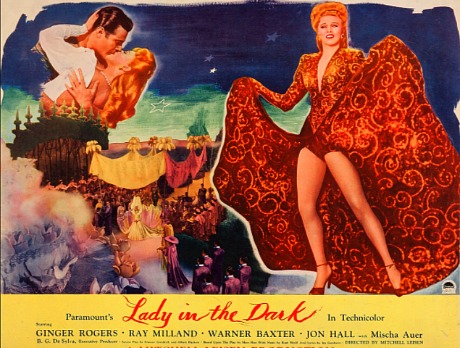Entertainment journalist-critic Chris Willman caught three of the four highly ballyhooed nitrate screenings shown during last week’s TCM Classic Film Festival. These films were Otto Preminger‘s Laura, Alfred Hitchcock‘s The Man Who Knew Too Much and Mitchell Leisen‘s Lady in the Dark. (Willman missed Michael Powell and Emeric Pressburger‘s Black Narcissus.)

Willman went each time with genuine eagerness, but he couldn’t quite see what the big deal was. Here’s his report:
“I saw three of the four nitrate screenings at the TCM Fest. I’ve been hesitant to publicly riff on them because I’m one of those non-audiophile people who would fail a vinyl/digital comparison test, so I may be equally blind when it comes to certain visual subtleties. That said, I was underwhelmed, at least after impossible expectations had been set up for how these prints would change our lives.
“Martin Scorsese introduced the first night and spoke in predictably entertaining terms about his own religious experiences with nitrate, dating back to seeing something at the old Melrose Theatre in the ‘80s. He and other speakers left the impression that we were about to see something that would be more vivid and startling than 3D, high frame rate and an acid trip combined.
“And then we saw the original The Man Who Knew Too Much, and it looked to me like a really good, albeit normal, 35mm print. I figured that might just be the limitations of 1930s photography and that Laura the following night would be the conversion experience. Again: I would not have thought it anything but a really strong 35mm print if I didn’t know any better. I missed Black Narcissus, which I think would have been the ultimate knockout of the four, if anything was going to be.
“I returned the final night for Lady in the Dark, hoping color would make all the difference for me. And on this one, I finally felt satisfied I was seeing something outside my norm, but I think that may have been more a reaction to the otherworldliness of well-preserved Technicolor than nitrate per se. (This one also seemed not very sharp to me, though I imagine that’s a quality of the original early ‘40s cinematography.) I couldn’t help but wonder if maybe the nitrate cult is a case of the emperor’s new clothes, or the emperor’s old clothes.
However, I saw at least one vintage film buff on Twitter writing that Laura was the most visually spectacular thing she’d ever seen on the big screen. So it’s entirely possible that these people who were knocked out were in the right and I am nitrate-blind, just like I’m vinyl-deaf. I’m really curious to see some more expert opinions than mine. And I wish I’d seen Narcissus — that might have been the one that would make me get it.
“Assuming the Egyptian will be showing more nitrates before the year is up, I’ll be back, for sure, trying to see what the buffs see. Maybe I was just too primed for some kind of transformative godhead to tune in to the subtler magic of the prints. Like I said, at least with Lady in the Dark, I felt satisfied that I was seeing some colors not found in nature, or on DCP or Blu-Ray.
“By the way, I really recommend Dawson City, the documentary that screened Friday about hundreds of reels of lost nitrate silents that were found buried in the Canadian permafrost. I think I saw on a postcard that it’s booked for the Nuart in May. A really transfixing film that doesn’t have any talking heads at all on screen to break the spell until the last 10 minutes or so. This film about nitrates was as magical as I wanted the actual nitrates to be.
“I’m sure some brief footage of a nitrate-based European cinema fire that killed scores of people back in the day gave a few people pause about going over to the Egyptian without a fire truck outside.”
